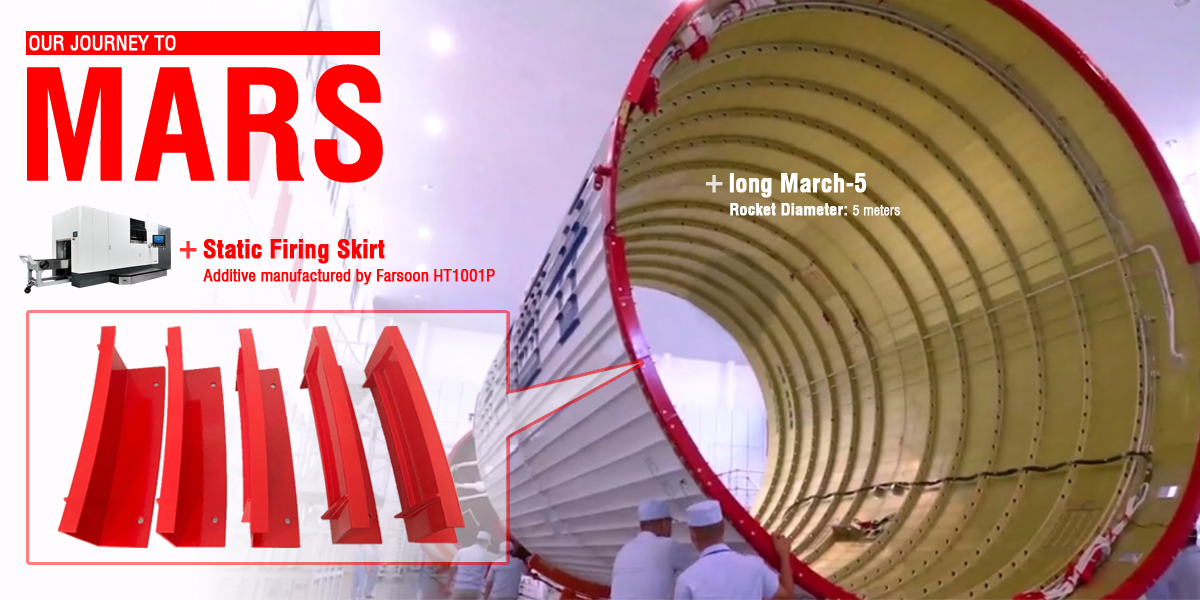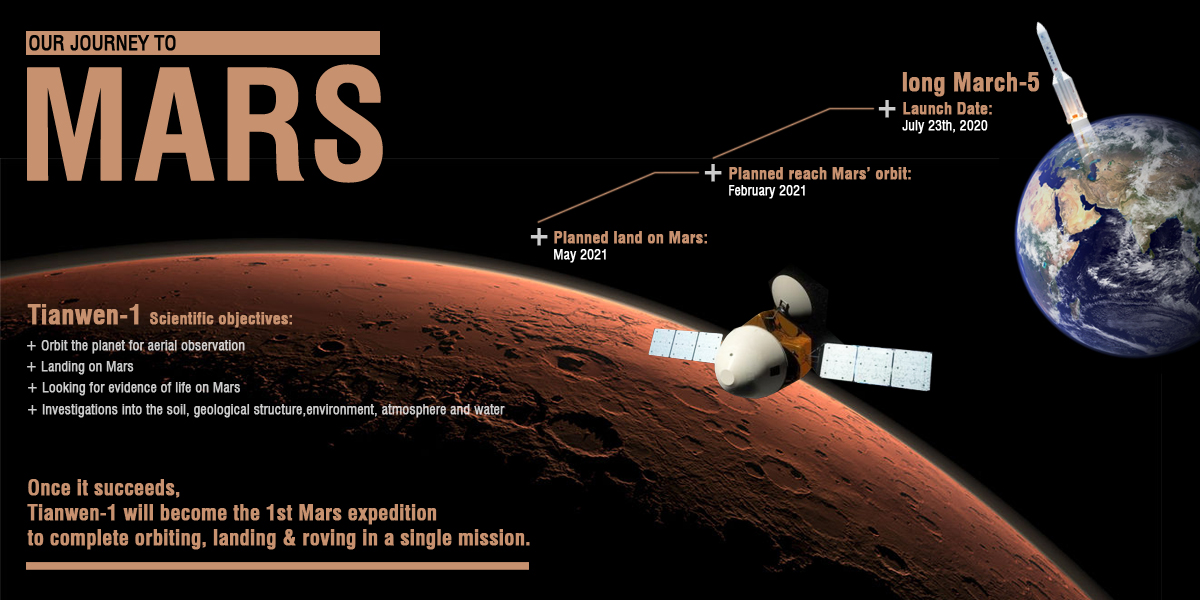China’s Long March-5 Rocket Has 50 3D Printed Parts
During the last two years, China has led the world in orbital launches, and 2020 seems to continue along that trend as the country’s space agency sends major exploration missions to space. Taking the first step in its planetary quest of the solar system, China sent a Long March 5-rocket to Mars. Not only is this its first launch vehicle designed from the ground up to focus on non-hypergolic liquid rocket propellants, but it also incorporates additively manufactured parts. For the job, local 3D printing system supplier Farsoon Technologies used a laser sintering platform and high-performance material to produce 50 parts for the rocket’s static firing skirt.
On July 23, the Long March-5 rocket blasted off Hainan Island’s Wenchang Space Launch Center, just miles off the coast of China’s mainland, carrying an orbiter, lander, and rover that will aim to tackle questions about the Red Planet’s geology, environment, and atmosphere composition. Few details about the mission have been released, even the name and logo were revealed only two months ahead of the launch, but once it arrives at the planned orbit in seven months, the robotic mission named Tianwen-1 – which translates to “questions about the heavens” – will attempt to deploy an orbiter above Mars and later deposit a lander and rover on the Martian surface,
Developed by the China Academy of Launch Vehicle Technology (CALT), the powerful Long March-5 heavy-lift rocket has a large five-meter diameter with four 3.35-meter boosters for carrying 25 tons of payload in low Earth orbit (LEO) and 14 tons in geo-synchronous transfer orbit. Featuring an efficient multi-stage design, the Long March-5 rocket jettisons stages of its structure when they run out of propellant, decreasing the mass of the remaining rocket and allowing the thrust of the remaining stages to more easily accelerate the rocket to its desired final speed and orbital height. Known in rocketry circles as staging, this process is repeated until the final stage’s motor burns to completion and involves a well-designed inter-stage structure system that requires highly functional, durable parts, including the static firing skirt.

3D printed static firing skirt parts for China’s Long March-5 rocket. (Image courtesy of Farsoon Technologies)
Among a number of supporting components, the static firing skirt provides a temporary structural medium between the stage and the aft support ring to protect the unlocking device, explained Farsoon Technologies. It is cylindrically shaped and fitted with internal and external lift points, facilitating stage handling. After careful evaluation, scientists designed the optimized static firing skirt per operating conditions and manufactured the end-use parts using Farsoon’s largest system for developing plastic parts, the HT1001P laser sintering platform, which features a 1,000x500x450 mm build cylinder. As for 3D printing materials, company engineers chose the high-performance polymer powder FS3300PA, due to its strength and toughness, ease of assembly, good post-processability for water-proofing, and salt spray to assess the extreme atmospheric corrosion resistance.
Continuous operation of the machine helped accelerate production and reduce manufacturing costs for the high-quality functional final static firing skirt, which was composed of 50 separate 3D printed pieces measuring 370 x 100 x 125 mm each, and produced in just 48 hours, as stated by Farsoon. Once assembled, the pieces made up a cylinder structure measuring 5,000 mm in diameter.
For now, Tianwen-1 has successfully carried out its first orbital correction on August 2, after traveling more than 230 hours in space and three million kilometers away from Earth, according to the China National Space Administration (CNSA). Once it succeeds, Tianwen-1 will become the first Mars expedition to complete orbiting, landing, and roving in a single mission. Once it reaches its destination, the heavy-lift rocket is expected to be joined by two other missions that also took off during the 2020 Mars-launching season, the United Arab Emirates Hope orbiter carrying the country’s first interplanetary probe, and the United States’ highly awaited Mars 2020 Perseverance Rover mission, aboard the Atlas V rocket.

From Earth to Mars, the Long March-5 rocket travels seven months before arriving at the Red Planet. (Image courtesy of Farsoon Technologies)
Headquartered in China’s southern province of Hunan, Farsoon Technologies was established in 2009 by laser sintering expert Xu Xiaoshu and has become a large system supplier of industrial plastic laser sintering and metal laser sintering systems. The company manages China’s first national 3D printing lab through a deal with the Chinese government and also expanded its direct sales of metal additive manufacturing in North America with the creation of Farsoon Americas.
By contributing to space science and continue to prove how 3D printing can be an innovative manufacturing method for a wide range of end-use applications, Farsoon has an important role in helping the Chinese space agency build a sustainable presence in the Red Planet and beyond. This is a new opportunity to extend the capabilities of additive manufacturing within spacecraft building for the future of the country, especially as China becomes a major space power in the region.
Subscribe to Our Email Newsletter
Stay up-to-date on all the latest news from the 3D printing industry and receive information and offers from third party vendors.
Print Services
You May Also Like
3D Printing Grows to $15.9B in 2024 Amid Shifting Industry Dynamics
The global additive manufacturing (AM) market reached $15.9 billion in calendar year 2024, according to “Q4 2024 3DP/AM Market Data and Forecast” from Additive Manufacturing Research (AM Research). Despite a...
3DPOD 247: LJ Holmes, Executive Director for the Center of Advanced Manufacturing and Materials at Harrisburg University
Executive Director for the Center of Advanced Manufacturing and Materials at Harrisburg University, Larry “LJ” Holmes is a pioneer in applying additive manufacturing to defense and other critical sectors. Part...
Thai Startup OsseoLabs to Cut Surgery Time with 3D Printed Magnesium Implants
A patient undergoing mandibular reconstructive surgery typically faces two separate operations: one to place a custom-fit titanium plate and another month later to remove it. But what if that second...
Japanese Advanced Manufacturing Capabilities Grow in Europe with Sodick’s Purchase of Prima Additive
The global economy is currently undergoing a reshuffling in terms of what gets manufactured where. In large part, this trend is being driven by new geopolitical alliances and the need...


























